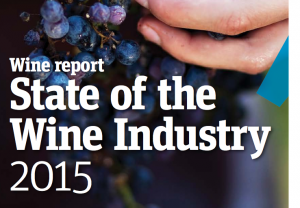 Silicon Valley Bank (Nasdaq: SIVB) released its Annual State of the Wine Industry report in a live broadcast today, indicating accelerating sales growth in the fine wine category of 14 to 18% in 2015.
Silicon Valley Bank (Nasdaq: SIVB) released its Annual State of the Wine Industry report in a live broadcast today, indicating accelerating sales growth in the fine wine category of 14 to 18% in 2015.
The growth will be driven by a strong US economy, said Silicon Valley Bank’s wine division founder Rob McMillan, who cited declining oil prices, improved employment statistics, a stronger US dollar, and a measured pace of interest rates as four factors contributing to the double-digit growth.
Wineries and organizations tuned in to the webinar from around the country. Foreign markets – including Australia, Canada, Chile, France, and Italy – were also represented.
The report is available online but the webinar featured insightful on-the-spot commentary from a panel of industry experts. Here are their highlights.
The fine wine category, where Silicon Valley Bank expects the strongest growth, is defined as $20 and above per bottle.
The demand for lower-priced wines ($15 and below) has been lagging, leading to excess supply. At the moment about 33 million gallons of wine is available on the bulk market. According to Glenn Proctor, partner in the Ciatti Company, the challenge will be moving through that inventory, in a category where the sales growth is not that strong.
That existing volume may impact the imports of good quality foreign-grown wine, which is readily available and has been incorporated into domestic labels for several years.
Price creep keeps going up as consumers accept quality wine at increasingly higher price categories, said Amy Hoopes, chief marketing officer and EVP of global sales at Wente Family estates.
“We’re training Millenials to drink foreign wine,” said McMillan, citing the success of wines from Chile, New Zealand, and more recently the Rioja region of Spain. “But how do we brand American wines? We have to be able to say something more than price. American-produced wines have to mean something. We have to get our hands around this for the long-term growth of the domestic industry.”
Paul Mabray, chief strategy officer at Vintank, thinks that we are living in the most competitive market in history for wine. Yet he sees a knowledge and resource gap occurring with wineries regarding digital presence and Direct To Consumer (DTC) sales, where the top 20% of wineries outperform the bottom 80%. Even if wineries try and fail, they’re failing forward, he said. “Even if they’re not succeeding, they’re still gaining knowledge.”
Mabray and Hoopes attribute the lack of engagement to strong enotourism initiatives. “But there is a ripple affect of not thinking mobile first,” Hoopes said. “There a ‘dark social’ area that’s not being tracked. It’s an untapped opportunity.”
“Data has come to a place where it’s finally usable,” Mabray said. “It took a long time to get there but maturation of the technology has caught up. There is stunning data, and stunning access.”
Regulatory issues that will impact the US wine industry in the coming years include water, air quality, and antiquated legislation regarding online communication about alcohol. “The laws need to change to accommodate our society today,” Mabray said. “The paralysis it causes wineries is unbelievable.”
Source: Forbes
